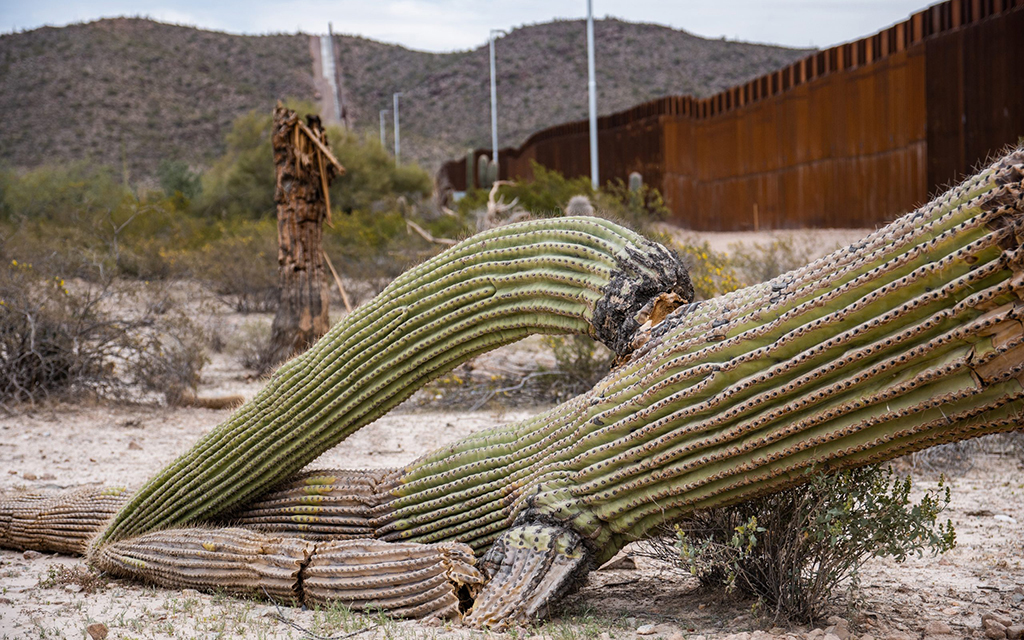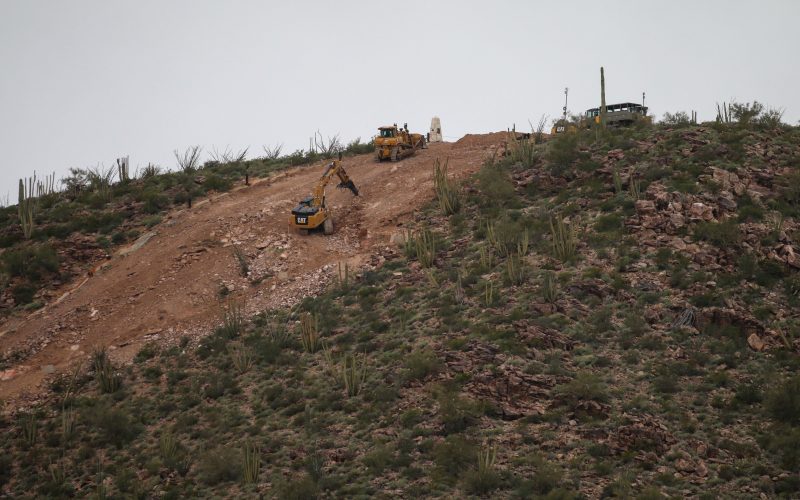
Efforts to replant saguaro cactuses that were moved for border wall construction were often unsuccessful, just one of the environmental harms outlined in a GAO report on the impact of the wall’s construction and its aftermath. (File photo by Isaac Stone Simonelli/Cronkite Borderlands Project)
WASHINGTON – A new Government Accountability Office report confirms what critics have long said, that the Trump administration’s rush to build a border wall caused significant environmental damage, depleted water sources and devastated sacred tribal sites.
The report also said that wall-related damage at the border has continued under the Biden administration, which ordered a pause in border wall construction on President Joe Biden’s first day that left sites abandoned and vulnerable to erosion and the elements.
“We reported that the pause in some cases did exacerbate conditions,” said Anna Maria Ortiz, the director of natural resources and environment for the GAO and an author of the report.
The 72-page report, released Thursday, was requested by Rep. Raúl Grijalva, D-Tucson, who said it shows that the wall “has been an ineffective waste of billions of American taxpayers’ dollars – and now we know it has caused immeasurable, irreparable harm to our environment and cultural heritage as well.”
Former President Donald Trump campaigned on a promise to build a wall on the border with Mexico, and ordered the work to begin as soon as he took office in 2017. Two years later, he declared a national emergency that ordered the Pentagon to assist in the project, directed Defense Department toward the wall and allowed agencies to waive environmental and other regulation as necessary to speed construction.
The emergency allowed federal agencies to award contracts for 631 miles of wall and begin construction on 458 miles, just under half of them in Arizona. But it also left devastation in its wake.
That included killing plants like the iconic saguaro cactus that were in the path of the wall and dynamiting Monument Hill, disturbing burial sites of Apache and O’odham ancestors and destroying land that was used by the Tohono O’odham for religious ceremonies. Crews disrupted Quitobaquito Springs, a desert oasis in the Sonoran Desert, and depleted groundwater supplies near the San Pedro River by drilling wells for water for construction.
The wall itself blocked access for all but the smallest animals in the region, including some that are threatened species. Lights on finished sections of the wall – and the report said only 69 miles were completely finished by the time Trump left office – disrupted behavior of animals in the area.
Problems continued when construction was paused and construction crews walked away from the sites. Saguaro – which a Tohono O’odham official told the GAO “is a sacred plant to be given utmost respect, as a relative” – that transplanted to make room for the wall were not tended after the pause in early 2021. As many as half of the transplanted cacti did not survive, according to a National Park Service official cited in the report.

Earthmoving equipment clears a path up Monument Hill in the Organ Pipe Cactus National Monument to make way for the border wall, threatening cactuses and migrating animals and damaging lands sacred the Tohono O’odham Nation. (File photo by Annabella Piunti/Cronkite News)
Workers also left behind roads and hillsides that were not protected from erosion. Silt from a construction staging area near the top of a mountain in the Pajarito Mountains is filling a pond in the Coronado National Forest, threatening a vital water source for cattle and wildlife.
Much of the erosion was observed by the GAO adjacent to the border wall along patrol roads where contractors did not complete installing culverts and other erosion control. The report said that in multiple locations erosion is so serious that is “threatening the integrity of the barrier system.”
“This report lays bare the incalculable damage border wall construction inflicted on wildlife, public lands and Indigenous nations,” Laiken Jordahl, Southwest conservation advocate at the Center for Biological Diversity, said in a statement Thursday.
“These border walls haven’t done a thing to address immigration or smuggling, but they did drive endangered species closer to extinction, butcher thousands of iconic saguaro cacti and dynamite Indigenous sacred sites and burial grounds,” Jordahl said. “This is a clear warning that any attempt to build additional miles of border walls would be a horrifically destructive and useless folly.”
Customs and Border Protection identified four areas to focus on after the pause in construction, beginning with addressing immediate safety hazards and going to mitigating environmental damage. But so far, little has been done on a repair list that the Interior Department estimates could cost $200 million for mitigation efforts alone.
The report recommends that CBP and Interior work together to create a “joint strategy to mitigate resource impacts,” identifying roles and responsibilities for each agency, costs and schedules. It also said CBP should “evaluate lessons learned from its assessments” and, most importantly, that the organizations communicate with one another on plans moving forward.
In written responses to the report, both CBP and Interior said they agree with the recommendations.
Grijalva said that not only must restoration be done, but it must be done right.
“So much damage has been done, but we still have the opportunity to keep it from getting worse,” he said in a statement.
“Environmental restoration and mitigation work must be led by science and input from the right stakeholders, including tribes and communities along the border,” Grijalva said. “So many corners were cut in building the wall – let’s not repeat history by cutting corners in repairing the damage it caused.”


